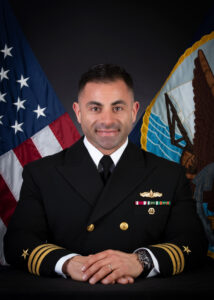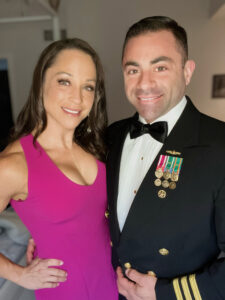
Contact Us if you would like to learn more about how we can help you or your business.
Don’t forget to follow Melanie Borden and The Borden Group on LinkedIn™ for more on all things social media marketing strategy.
Do you know anyone in the Navy? Do you know what he or she does and what his or her experiences have been? A non-military citizen often acknowledges the service of someone active or retired by saying “thank you for your service” but do not usually ask about their experiences. Sharing our experiences in the Navy is one way that we, as a service, to stay connected and stay relevant to the non-military majority of America – for context, roughly one half of one percent (0.5%) of the U.S. population is one active duty service.
I’ve spent fifteen years on active duty as a Naval Officer, serving has been an incredible privilege. After four ships, twenty-three countries, ten moves, one command tour, and another command tour on the horizon I still wake up excited for what I do. I’ve met so many wonderful people, had some incredible experiences, and, most importantly, been able to impact so many lives.
As a Naval Officer, professional mariner, and leader, I often get asked how to be a good leader. Although my experiences are unique to my profession, I’d be the first person to say that being a good leader is a personal journey. I’ve had some positive leadership experiences and I’ve had my share that weren’t so positive. Perhaps I’ve had a few more “wins” on the positive side, so by nature, that makes me “successful.” Everyone has their own definition of leadership and how to apply it, but I think leadership is the ability to impact someone else through decision-making—good leaders foster environments where those around them feel empowered to act and be open to feedback.
In the last few years, I’ve focused more on how to help others become better leaders. Leader development takes time, patience, various opportunities to practice leadership, and a good coach. The coaching piece is something I’ve begun to focus on. More and more people will ask me for advice about working problems within their teams or issues their company is having and how to approach them. Having time to sit down and think, I’ve developed my coaching tools and “The Leadership Wake.” Naturally, I stuck with the maritime theme, but the visual works for almost everyone I describe it to. The Leadership Wake discusses the ownership of who you are and the people you inspire.

Your wake is your legacy. Your legacy is a function of two components: time and people. The longer you live and the more people you interact with, the larger your wake. You see that beautiful wake as you look out from the back of a large ship. The water closest to the ship is white and light blue from all the disturbance and bubbles created by the propellers, but the further you get from the ship, you can see the wake grow more expansive and smooth. There’s a clear distinction between the wake and the water around it. So is the same true with your legacy. Each day, we make decisions that affect those around us, whether or not we acknowledge it, for better or worse. Each of those decisions creates that white and light blue, disturbed water with bubbles, but as the days pass, the impacts of that decision become more apparent.
Decisions require leaders, and leaders make decisions. Without any decisions, there would only be managers to “keep the train on the tracks” and the machine moving. But true leaders lead in the face of adversity and options. What I’ve been focusing on in the last few years, and how I coach people, is to think beyond the decision and how that impacts the people involved. Humanizing a decision or a process becomes much more meaningful and impactful. Every decision has a human element, and it’s easy to ignore. Sometimes, leaders become so focused on the outcome or arrival at an end state that, in the process, they need to remember the people involved. However, leadership is not only about decision making, it’s about people. People want to be led. As a leader, at any level, ask yourself, “what legacy am I leaving? What wake am I leaving each day when interacting with people around me?”
A legacy is something that requires management, purpose, and work. You must decide what you want to put in your wake and what you don’t. It would be best if you steered the ship of your life away from the objects you don’t want in your path. Sometimes, those “objects” can be people, drama, finances, etc. Coaching has allowed me to get to know so many wonderful people and understand their journey, where they are now, and where they want to get to. Most of them know where they want to go, but my purpose as the coach is to ask the right questions to get them to understand how to get there. Seeing someone succeed and the excitement of success is a joy to witness every time it happens.

So, as I sit in my “Captain’s Chair” of my ship (my life), looking at my wake makes me pause to think of all the people I’ve encountered. I’ll steer clear of some of those people in the future to keep them out of my wake, but I’ll turn toward others at each opportunity because they continue to enrich my life. The Navy has been an incredible adventure for me, but at some point, that part of my life will sunset, and I’ll be off to something even more exciting. Leadership coaching, being a charter captain, and continuing to be a father and husband. Those are things that I will continue to steer towards and develop. They are all passions in my life. Marrying my best friend and becoming parents together was the most incredible experience of my life. My family is my “why” for what I do.
As you manage your wake, find your why. It will always be your “true north” and where your internal compass points to. After that, find the things that drive you, that you are passionate about, and the people that make those passions worth doing. Once you connect all those things, the decisions you make as a leader and the impacts on people will become much easier, more gratifying, and more meaningful.
I wish you calm seas and smooth sailing!
Want to learn more about this topic? Make sure to follow Anthony LaVopa on LinkedIn™. Love our content? Join the Human to Brand Community!
Contact Us if you would like to learn more about how we can help you or your business.
Don’t forget to follow Melanie Borden and The Borden Group on LinkedIn™ for more on all things social media marketing strategy.
Copyright © 2025 | The Borden Group | All Rights Reserved